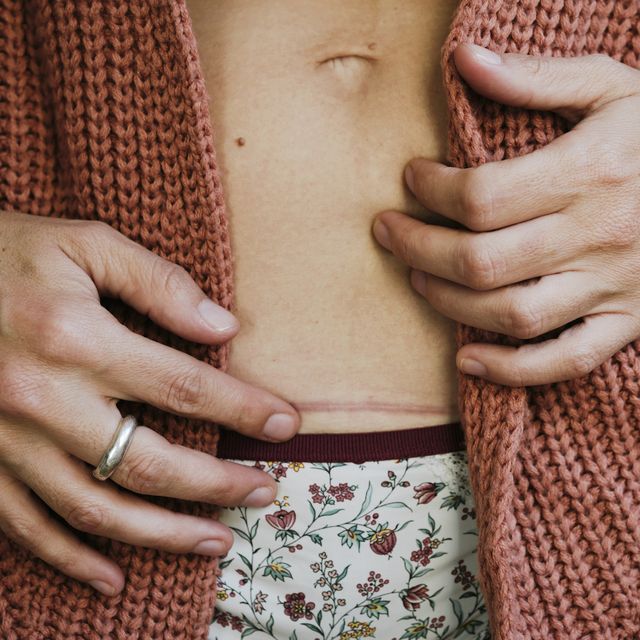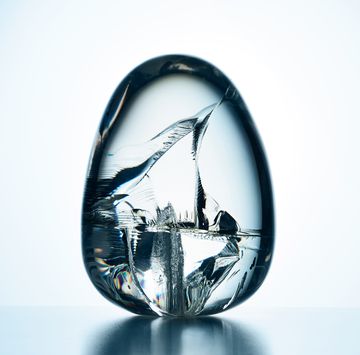Most pregnant women aren’t exactly lining up to give birth via caesarian section, but C-sections happen pretty often. According to the Centers for Disease Control and Prevention (CDC), 32 percent of babies delivered in the U.S. in 2017 were born via C-section.
In case you're unfamiliar, a C-section is when your doctor delivers a baby through incisions that are made in a woman's abdomen and uterus. There are a bunch of different reasons why you might need to have a C-section, including delays in the progression of labor, your baby being in a breech position, and having a really large baby, according to the American College of Obstetricians and Gynecologists (ACOG).
Hearing you need to have a C-section birth can raise a lot of questions, including an army of Qs about the scarring that can happen afterwards. For the record, every woman and every delivery is a little bit different, and that’s also true for scars. But there are a few things you should know about C-section scars, plus how they heal—and top ob-gyns are here with all of the answers. Let's get to it.
Are there different kinds of C-section incisions?
On the skin of your abdomen, as well as on your uterus, you can have incisions that are vertical or horizontal, says Jessica Shepherd, MD, an ob-gyn in Texas. This largely depends on whether you’ve had a C-section in the past, if you’re giving birth to multiples, if you’re having an emergency C-section, and your own BMI, she says.
What kinds of closure methods are used for C-section incisions?
Once the baby is delivered, the incisions have to be closed up again. Doctors generally choose between using glue or doing stitches, Dr. Shepherd says. Worth pointing out: There really isn’t any hard data to say that one is better than the other.
“The scar is only affected by what the skin incision direction is,” Dr. Shepherd says. “The vertical skin incisions are more painful when healing and can be not as cosmetically appealing,” she says, meaning, it might be more likely to leave a scar.
What is the healing process like for C-section incisions?
After your incision is closed, your doctor will put Steri-Strips on. These are sticky, paper, tape-like strips that help keep your wound closed and clean. In general, the Steri-Strips may stay on until you see your doctor again two weeks after you gave birth, or they might fall off on their own at home.
During the healing process, keep the incision area dry and clean. You may have a ridge over your scar for a bit at first, but that will slowly get smaller over time. “Incisions heal just like any cut on the body and start with very pink skin edges, then the edges come together,” Dr. Shepherd says.
How do you clean a C-section incision?
Once a day, use warm soapy water to wash the incision, and pat dry after cleaning, says Dr. Shepherd. Outside of cleansing, your doctor will likely recommended keeping the wound covered with bandages over the Steri-Strips.
How long does it take for C-section incisions to heal?
The incision heals over three to six months and the scar “fades to some degree over a few years,” Dr. Shepherd says, adding that everyone heals a little differently. By three months, your scar should “definitely be a lot less noticeable,” says Sherry Ross, MD, an ob/gyn at Providence Saint John’s Health Center in Santa Monica, California.
Do C-section scars go away?
Not really, but it will fade. “A C-section scar will never entirely go away. It always leaves some sort of imprint on the skin,” says Dr. Ross. But, depending on how your scar heals, it can become “very thin and unnoticeable,” Dr. Ross says.
Do C-section incisions and scars hurt?
At first, yeah, the incision is probably not going to feel amazing. “C-section incisions can hurt, especially in the first few weeks when the healing process is very new,” Dr. Shepherd says. (Your doctor will likely give you pain medication to help.) But, over time, the incision doesn’t hurt. However, sometimes women say they have sharp pains that come and go, Dr. Shepherd says. If your C-section scar hurts after the initial healing phase, definitely bring it up with your doctor.
Is it normal for C-section scars to be itchy and irritated?
That’s actually pretty common, Dr. Ross says. Some of the superficial nerves in your skin were cut during the birth, and the recovery process can make the area “hyper sensitive and cause a little bit of itching,” Dr. Ross says. Not everyone experiences this, BTW, but it can happen.
Is it normal to have a numb C-section scar?
If you don’t have any feeling over your scar, don’t panic: It’s normal. “A numbing sensation is very common a few weeks and months into the healing process,” Dr. Shepherd says.
Are there cosmetic fixes for C-section scars?
During the healing process, you may want to apply vitamin E cream to the scar, which may help it fade, Dr. Ross says. You can also use silicone tape on the area for three to six months after your birth. “That helps very well with the cosmetic look of the scar,” Dr. Ross says.
But if your scar is keloid (meaning it’s raised), the only way to totally fix it is to have a surgical wound revision, Dr. Shepherd says. If you’re not loving the way your scar looks, Dr. Ross recommends talking to your dermatologist about your options, like laser resurfacing.
Either way, know that C-sections (and C-section scars) are super common. You’re definitely not the only one walking around with a badass battle scar.













